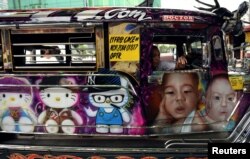A mass transit strike in the Philippines this week risks more disruptive collective action unless drivers and the government settle differences over costly upgrades to an aging yet iconic vehicle fleet, analysts say.
Thousands of drivers and operators of "jeepneys" went on strike Monday and Tuesday. The government called for two days off work and school to minimize disruption for commuters. Jeepneys are distinctly Philippine vehicles that are about the size of small buses and provide most urban mass transit.
President Rodrigo Duterte wants the aging fleet replaced by January 1 to combat air pollution. But operators may lack the money for vehicle replacements. Experts say a new strike could erupt without compromise by officials, disrupting already difficult commutes in major cities such as the capital, Manila.
"They have to meet in the middle," said Jonathan Ravelas, chief market strategist with Banco de Oro UniBank in Metro Manila. "So, it's more of a communication problem to probably try to address both areas, making government aware of certain things. They just have to do a compromise somewhere."
Costly demand
The drivers went on strike to draw attention to the role of their smoke-belching but colorfully decorated vehicles. Some people carried flags and placards; a few blocked roads. Smaller strikes were held last month and in February for the same cause.
The Philippine government last year approved a modernization program to replace jeepneys older than 15 years with low-polluting vehicles, such as solar-powered ones.
It has neither offered financing to the operators nor addressed a likely increase in passenger fares on newer jeepneys, said Maria Ela Atienza, political science professor at the University of the Philippines Diliman.
"It seems like the government is already set to implement the phase-out of the jeepneys by January of next year," Atienza said. "So it appears to disregard the livelihood of a mass of jeepney drivers who will lose their jobs. They won't [have] money to pay for the new units, so many of them will be jobless."
A political camp called Piston Partylist is speaking out for drivers' interests in the legislature, adding a political element to the dispute. Experts expect more strikes over the next two months unless drivers reach a deal with the government.
Cultural icon
Jeepneys emerged after U.S. colonization of the Philippines ended in 1946. In much of the country, passengers can hail them from any roadside. They pay according to distance traveled, sometimes as little as 14 cents (seven pesos). Passengers normally sit on two long benches facing each other in a pickup truck-style bed covered with a roof. Passengers help one another pass fares up to the driver and pass back any change.
Operators often paint the vehicles in their own style and name them after women or religious figures, making the vehicles a hallmark of Philippine culture.
In Philippine cities, jeepneys provide most of the local mass transit because of the lack of bus systems or wide-reaching commuter rail networks.
Reaching a compromise on vehicle replacement could be tough in today's political climate, said Christian de Guzman, vice president and senior credit officer with Moody's in Singapore. He cites a "heightened level of noise" and "confrontational politics" since Duterte took office in June last year.
"If you go to social media, there's certainly a great degree of polarization that has happened over a fairly short amount of time," de Guzman said. "Since Duterte has come in, there's this 'with-us-or-against-us' type of mentality."
Threat of more strikes
The strike earlier this week "barely affected the riding public," the presidential office said on its website.
But repeated transit strikes or a prolonged one would eat away at commerce if people face trouble getting to work, analysts say. Low-paid commuters would also need to pay more for taxis or ride-sharing apps.
Participants in major events such as the Association of Southeast Asian Nations leadership summit scheduled for Nov. 10 to 14 in Manila use private cars, leading to little disruption. If the summit coincides with a strike, delegates will find relatively little traffic in the typically gridlocked city.
"It's sad to say, but if you ask me, traffic was tolerable," Ravelas said, recounting the strike this week. "It just highlights the main problem, which is too many vehicles."







